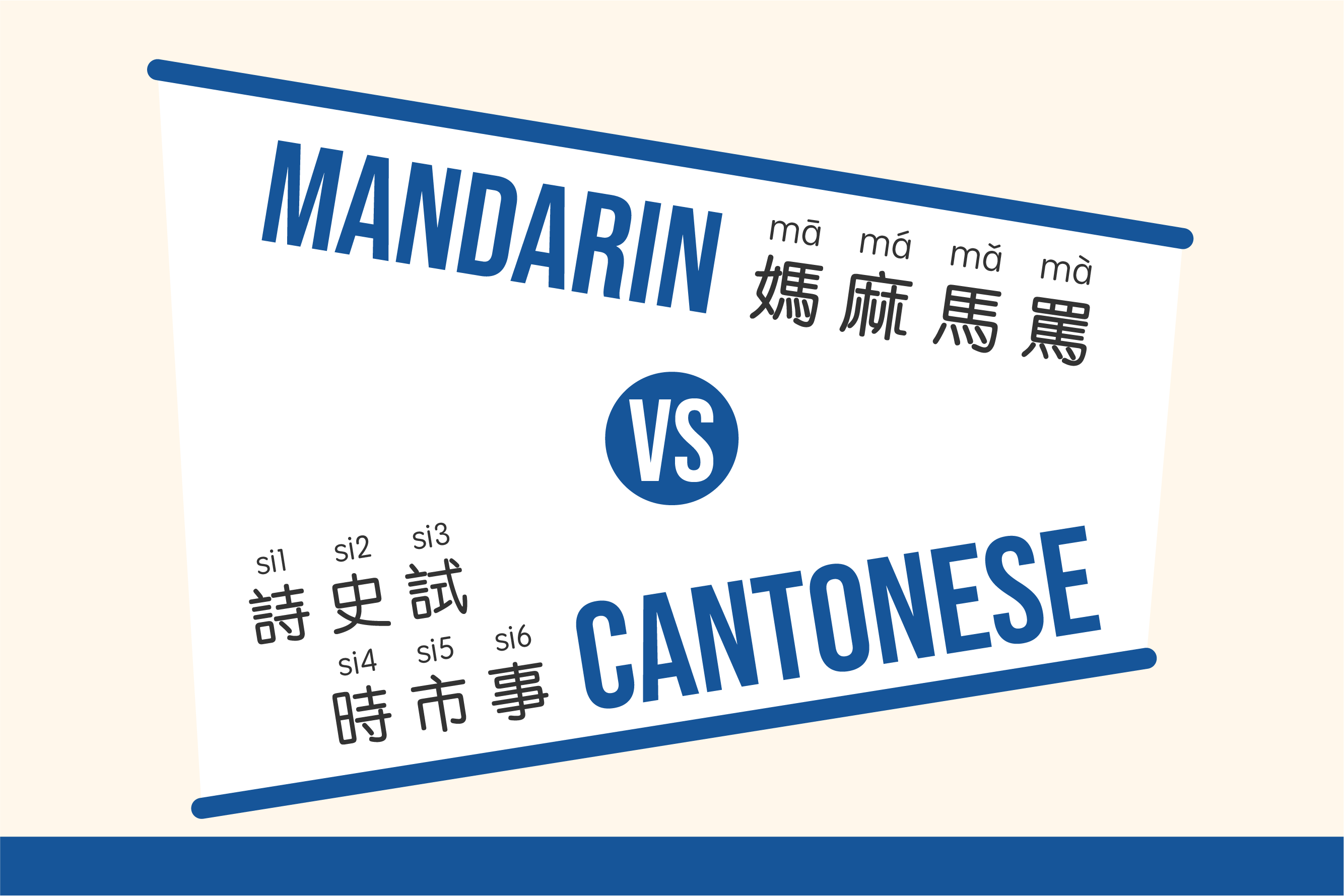Table of Content
Cantonese is often considered a dialect of Mandarin Chinese. However, according to linguistic classification, a dialect is considered as such when speakers of two languages can communicate without prior exposure or training, i.e., mutual intelligibility. Although Mandarin and Cantonese both use the Chinese writing system, just as different European languages use Latin script or its variations, it doesn't mean they are the same language.
6 Differences between Cantonese and Mandarin
Pronunciation (regarding the same Chinese character)
Tones
Final Particles
Vocabulary
Grammar
Romanization System
1 - Pronunciation
The pronunciation of Mandarin and Cantonese differs significantly, even when pronouncing the same Chinese characters (Note that people in China use simplified Chinese characters (簡體字), while most people in Hong Kong, Macau and Taiwan use traditional Chinese character (繁體字)). In fact, very few Chinese characters are pronounced the same in Mandarin and Cantonese.
Example:
I love you | |
|---|---|
Cantonese | 我愛你 |
Mandarin | 我愛你 |
2 - Tones
Both of the languages are tonal languages, which means that even the same vowel and consonant combinations can have different meanings depending on different tones.
Cantonese has 6 major tones, while Mandarin has only 4 major tones, making Cantonese phonetically richer and more varied than Mandarin.
Cantonese
Tone | Description | Example |
|---|---|---|
1st | High flat | 詩 - - poem |
2nd | High rising | 史 - - history |
3rd | Mid flat | 試 - - to try |
4th | Low falling | 時 - - time |
5th | Low rising | 市 - - market |
6th | Low flat | 事 - - matter |
Mandarin
Tone | Description | Example |
|---|---|---|
1st | High flat | 媽 - - mother |
2nd | Rising | 麻 - - hemp |
3rd | Falling then rising | 馬 - - horse |
4th | Sharp fall | 罵 - - scold |
- | Light and quick | 嗎 - - question particle |
3 - Final Particles
While both Cantonese and Mandarin have final particles to modify the mood of the speaker or the meaning of the sentence, note that Cantonese has more of them, and they can convey different meanings based on tone variations.
Common particles | Distinct Particles | |
|---|---|---|
Cantonese | 呀 呢 啦 | 喎 咩 嘅 啫 咋 啩 先 囉 㗎 |
Mandarin | 吧 了 哦 嗎 嘛 啊 |
4 - Vocabulary
Some vocabulary is shared between Cantonese and Mandarin, meaning that when expressing the same meaning, the written characters are the same (but pronounced differently), most of these are nouns.
But there are also some words that are distinct in each language. Mandarin and Cantonese may use different characters to convey the same idea, such as 這 in Mandarin is 呢 in Cantonese. Of course, the pronunciation will be significantly different. After all, they are different Chinese characters.
Below are some examples:
Examples | Cantonese | Mandarin |
|---|---|---|
This | 呢 | 這 |
is | 係 | 是 |
's [possessive] | 嘅 | 的 |
[perfective particle] | 咗 | 了 |
5 - Grammar
While some grammar structures are shared between Cantonese and Mandarin, such as Subject-Verb-Object sentence structure (which is same as English) and the way of how to use certain prepositions, there are still some grammatical differences, such as sentence structures when doing comparison and the order of double object sentences.
Example: Comparison sentence
I am taller than you | |
|---|---|
Cantonese | 我高過你 |
Mandarin | 我比你高 |
我 | 高 | 過/比 | 你 |
|---|---|---|---|
I | tall | -er than | you |
pn. | adj. | prep. | pn. |
Example: Double object sentences (direct + indirect obj.)
I give you a bunch of flowers | |
|---|---|
Cantonese | 我送(一)紮花俾你 |
Mandarin | 我送(給)你一束花 |
我 | 送 | 紮/束 | 花 | 俾/給 | 你 |
|---|---|---|---|---|---|
I | give | bunch | flowers | to | you |
pn. | v. | qualifier | n. | prep. | pn. |
6 - Romanization System
As Cantonese and Mandarin are two sets of languages with their own distinctive phonological features, they use different sets of romanization system as well.
Cantonese | Mandarin |
|---|---|
LSHK Jyutping | Pinyin |
Yale Romanisation | |
Sidney Lau Romanisation |
LSHK Jyutping is the newest type of romanisation system, developed by the Linguistic Society of Hong Kong in 1993. Our platform mainly use this system in romanisation too. You may find more useful information about it in 粵拼 JyutPing as well.
All in all, while Mandarin and Cantonese share some vocabulary and grammar, their different pronunciations (the main factor preventing mutual intelligibility), along with Cantonese having two more tones and their differences in vocabulary and grammar, mean that speakers cannot understand each other without prior exposure or learning. Therefore, linguistically, they are considered two related but distinct and independent languages.
